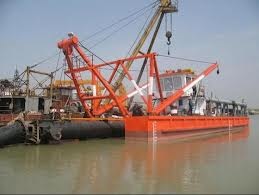Dredging Equipment
With many different excavation options, the only way to successfully remove silt, oil and dirt from underwater locations is through the use of dredging equipment. Without the use of what is commonly referred to as a dredger, digging beneath bodies of water like rivers, canals, lakes, oceans, ponds and estuaries is simply not possible. Whether mining underwater or creating complex navigation systems like underwater pipelines, the only way to successfully accomplish this unique construction process is by using dredging machinery.
Not only is this particular type of machinery used for building and digging in the sub aquatic, it is also essential for cleaning various types of environmental pollution and unwanted water soaked debris.
How Dredging Machines Work
For dredging equipment to properly function underwater, they are usually connected to hydrodynamic, mechanical or hydraulic construction equipment that float on top of the waters’ surface.
When using a motorized dredge, a drag line or continual line of buckets are often necessary in order for the excavation of dirt or other rubble from the bottom of different bodies of water. Moving from the dredging equipment to a large barge or container, the excavated material is then safely stored so that it will not reenter the waters’ surface.
When using hydraulic dredging equipment, the use of a sub aquatic pipeline is required to fasten to the digging machinery enabling all of the materials buried in the underwater floor to be sucked out from the bottom. Similar to a gigantic vacuum cleaner, this specific dredger is connected to an enormous hose that sucks everything up from the underwater floor. With a specialized digging tool attached to the dredger hose, this piece of equipment is able to dig while providing high pressure suction.
After the pipeline begins to drain all of the desired sediments, everything is then transferred to a specified location like a landfill site or beach area. A great example of this is the large piece of equipment, owned and operated by HESS. It was damaged in the Gulf of Mexico and leaked over 1 billion gallons of oil into the ocean waters.
Another way that hydraulic dredging is performed is through propelled machinery like a hopper dredge. Although somewhat complicated, this process uses the strong suction to transport and store the dug up materials into a hopper that will later bring the sediments to floating storage devices or offshore management facilities. An important issue that is regularly debated in regards to underwater dredging is the storage and cleanup of the dug up materials.
Dredging Equipment in the United States
Commonly practiced within the United States, dredging and its equipment are continually regulated by the American government so that waste, debris and litter are not frequently dumped into bodies of water. On top of the regulation of sub aquatic dredging, a very controversial aspect of this type of construction is the extremely high expense that is incurred. Because of the high expense of dredging equipment, along with the lavish price of storage, the process to dig underwater should not be underestimated.
